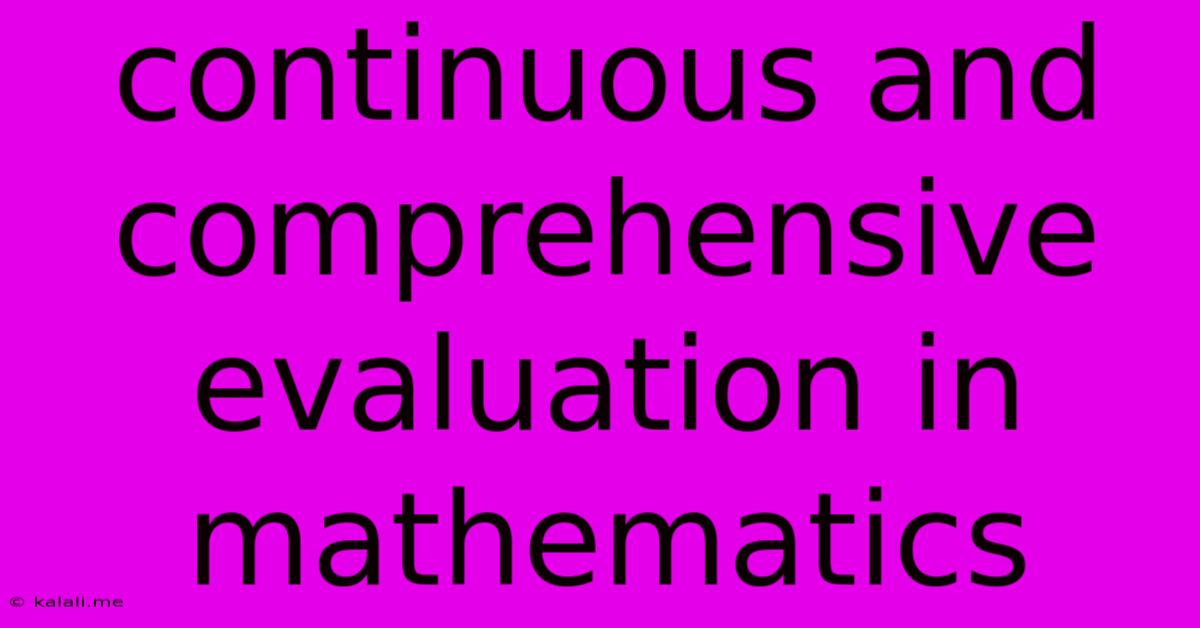Continuous And Comprehensive Evaluation In Mathematics
Kalali
Jun 15, 2025 · 3 min read

Table of Contents
Continuous and Comprehensive Evaluation (CCE) in Mathematics: A Holistic Approach to Learning
Continuous and Comprehensive Evaluation (CCE) is a holistic approach to assessment that moves beyond traditional, end-of-term exams. This article explores the implementation and benefits of CCE in mathematics education, focusing on how it fosters a deeper understanding and appreciation of the subject. It's a system designed to track student progress consistently, providing valuable insights for both teachers and learners.
What is CCE in Mathematics?
CCE in mathematics isn't just about grades; it's about understanding the entire learning process. It involves a continuous assessment of a student's mathematical abilities throughout the academic year, utilizing a variety of methods. This goes beyond rote memorization and focuses on evaluating comprehension, problem-solving skills, application of concepts, and critical thinking. Instead of relying solely on high-stakes examinations, CCE incorporates various assessment tools to provide a comprehensive picture of a student's mathematical development.
Key Components of CCE in Mathematics:
-
Formative Assessment: This ongoing assessment happens throughout the teaching process. It includes activities like classroom discussions, quizzes, individual and group assignments, presentations, and informal observations. This allows teachers to identify learning gaps early on and adjust their teaching strategies accordingly. Examples in mathematics could include short, in-class problem-solving sessions or quick checks for understanding after introducing a new concept.
-
Summative Assessment: This occurs at the end of a unit or term and provides a summary of student learning. Summative assessments could include tests, projects, and larger assignments that require application of previously learned concepts. A mathematics example could be a comprehensive exam covering multiple chapters or a project involving real-world application of mathematical principles.
-
Diagnostic Assessment: This type of assessment is used to identify students' prior knowledge and any misconceptions they may have. It informs teachers about the starting point for their instruction, enabling them to tailor their teaching to meet the specific needs of their students. In mathematics, this could be a pre-test on prerequisite knowledge or an initial assessment of problem-solving skills.
-
Project Work: Mathematics projects encourage students to apply their knowledge to real-world problems, fostering creativity and deeper understanding. These projects can involve research, data analysis, and presentation of findings. Examples could include creating a mathematical model of a real-world phenomenon or designing a solution to a practical problem using mathematical principles.
-
Portfolio Assessment: Maintaining a portfolio allows students to showcase their progress over time. It provides a collection of their work, demonstrating their growth and improvement in various aspects of mathematics. This can be particularly useful for tracking progress in problem-solving skills or conceptual understanding.
Benefits of CCE in Mathematics:
-
Early Identification of Learning Gaps: Continuous assessment allows teachers to pinpoint areas where students are struggling early on, allowing for timely intervention and support.
-
Reduced Exam Stress: The emphasis shifts from high-stakes exams to ongoing learning, reducing pressure and anxiety for students.
-
Improved Student Engagement: A variety of assessment methods makes learning more engaging and caters to diverse learning styles.
-
Holistic Development: CCE assesses not only mathematical skills but also critical thinking, problem-solving, and collaboration.
-
Personalized Learning: Teachers can use the data gathered from CCE to tailor their instruction to meet the individual needs of their students.
-
Enhanced Teacher-Student Interaction: CCE facilitates more frequent interaction between teachers and students, fostering a more supportive and collaborative learning environment.
Implementing CCE in Mathematics Effectively:
Successful implementation requires careful planning, training for teachers, and the development of appropriate assessment tools. A crucial aspect is creating a supportive classroom environment where students feel comfortable taking risks and learning from their mistakes. Regular feedback is essential, both for students and teachers, to guide the learning process and ensure that adjustments are made as needed.
By embracing CCE, mathematics education can move towards a more holistic, learner-centered approach that fosters a deeper understanding and appreciation of the subject, empowering students to become confident and capable mathematical thinkers.
Latest Posts
Latest Posts
-
Unit Of Pressure In Cgs System
Jun 15, 2025
-
Difference Between Percent Abundance And Relative Abundance
Jun 15, 2025
-
Which Of The Following Is An Example Of An Angiosperm
Jun 15, 2025
-
Is Milk Of Magnesia A Base Or An Acid
Jun 15, 2025
-
Which Two Of The Following Statements Are True Regarding Firewalls
Jun 15, 2025
Related Post
Thank you for visiting our website which covers about Continuous And Comprehensive Evaluation In Mathematics . We hope the information provided has been useful to you. Feel free to contact us if you have any questions or need further assistance. See you next time and don't miss to bookmark.